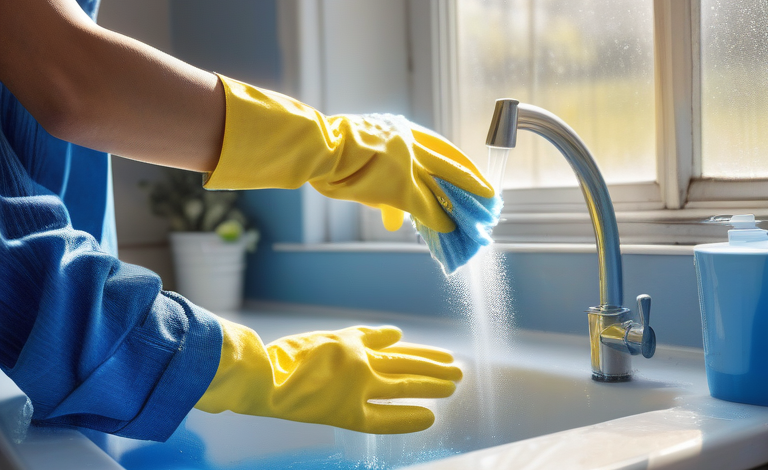How Long To Soak Clothes in Bleach: Expert Advice


Key Highlights
- Learn the recommended soaking duration for clothes in bleach to achieve optimal results.
- Understand the importance of fabric type and color when using bleach for laundry care.
- Discover the various types of bleach and their appropriate uses for different fabrics.
- Find out how to prepare and test your laundry before bleaching to avoid damage.
- Explore safety tips and best practices for using bleach effectively and securely.
- Get insights into neutralizing bleach, handling spills, and ensuring safe practices for laundry care.
Introduction
Understanding how long to soak clothes in **Clorox** bleach can greatly impact the outcome of your laundry. Bleach, especially **Clorox® Disinfecting Bleach**, is a powerful tool for removing tough stains, such as ketchup, and disinfecting fabrics. However, incorrect usage can lead to damage or ineffective results. By following expert advice and mastering the basics of bleaching clothes, you can achieve pristine whites and effectively tackle stubborn stains. This guide will walk you through the essential steps to safely and efficiently bleach your garments for optimal results.
Understanding the Basics of Bleaching Clothes
Bleaching clothes involves using chlorine bleach or oxygen bleach to remove stains and odors from fabrics, including white underwear and other garments. Chlorine bleach works best with white underwear and white clothes and hot water, while oxygen bleach is gentler and suitable for colored fabrics, including those made from mohair. Understanding the fiber content and type of material of your clothes helps determine the type of bleach to use. Always refer to care labels for guidance. Bleach can disinfect, whiten, and brighten fabrics, but it’s crucial to follow safety precautions and instructions for best results.
The Role of Bleach in Laundry Care
- Bleach plays a crucial role in laundry care by effectively removing tough stains and disinfecting fabrics.
- It is commonly used to brighten white clothes and sanitize laundry items.
- Chlorine bleach, a common type of bleach, works by breaking down stains and killing germs.
- When used appropriately, bleach can enhance the cleanliness and appearance of garments.
- Understanding how to properly incorporate bleach into your laundry routine can lead to cleaner and fresher clothing.
Types of Bleach and Their Uses for Different Fabrics
Chlorine bleach is effective for maintaining white clothing and hot water wash cycles, enhancing their whiteness for your white clothing. Sodium hypochlorite is commonly used for white garments. An effective bleach alternative, oxygen bleach works well on washable fabrics, while hydrogen peroxide is gentler for delicate fibers. Consider the fiber content and care labels when choosing bleach. For stubborn stains like red wine or berries on natural fibers, chlorine bleach is ideal. Always follow manufacturer instructions for bleach products to ensure the best laundry results.
Preparing Your Laundry for Bleaching
Sorting clothes by color and fabric type is crucial before bleaching to prevent color transfer or damage. Testing fabric colorfastness beforehand is essential to avoid unwanted discoloration. By following care labels and separating white clothes from colored ones, you ensure a successful bleaching process. Understanding the fiber content of each garment helps determine the appropriate bleach type and soaking method. Taking these steps prepares your laundry for effective bleaching without compromising the fabric integrity.
Sorting Clothes by Color and Fabric Type
- To achieve optimal results when bleaching clothes, sorting them by color and fabric type is crucial.
- Whites are typically safe for chlorine bleach, while colored items fare better with oxygen bleach to prevent discoloration.
- Sorting based on fabric composition is essential too – natural fibers like cotton can withstand bleach better than delicate fabrics such as wool or spandex.
- Taking the time to categorize your laundry before bleaching ensures the best outcomes and prolongs the lifespan of your garments.
Testing Fabric Colorfastness Before Bleaching
Before bleaching, it’s crucial to test fabric colorfastness. To do this, dampen a hidden area of the garment and apply a small amount of bleach solution. Wait for a few minutes, then blot dry. If there’s no color change or damage, the fabric is likely safe for bleaching. This simple test helps prevent unwanted discoloration or damage to your clothes when using bleach. Remember, different fabrics react uniquely to bleach, so this step is essential for optimal results.
Step-by-Step Guide to Soaking Clothes in Bleach
Mix the bleach solution by combining a cup of bleach with a gallon of water. Submerge the clothes completely, including any white cloth, ensuring even saturation. For enhanced cleaning, you may also consider adding laundry detergent or washing soda to the mix, or even soda for additional cleaning power. Allow them to soak for the recommended time based on their fabric type. For white clothes or heavily soiled items, a longer soak might be necessary. After soaking, wash the clothes in the hottest water suitable for the fabric using regular detergent. Ensure proper ventilation when working with bleach to avoid inhaling fumes.
How to Mix the Perfect Bleach Solution
To mix the perfect bleach and warm water solution, start by diluting chlorine bleach in a gallon of water. For white clothes, especially if you’re working with a white shirt, use ¾ cup of bleach per gallon of cold water; for colored items, opt for color-safe oxygen bleach. Ensure thorough mixing. Check care labels and perform a patch test to avoid damage. Always add bleach after detergent in the wash cycle. Avoid using hot or warm water with bleach. Remember, different fabrics, including a white shirt, require different concentrations, so be mindful of the fiber content when mixing your bleach solution.
Determining the Ideal Soaking Duration for Various Fabrics
- To determine the ideal soaking duration for various fabrics, consider the fabric type and the level of staining.
- Delicate fabrics like silk or wool should only soak for 15-30 minutes to prevent damage.
- Tougher fabrics such as cotton or polyester can tolerate longer soaking times of up to 1-2 hours for stubborn stains.
- Always follow care labels for specific instructions.
- Adjust the soaking duration based on the fabric’s reaction to bleach, ensuring effective stain removal without compromising fabric integrity.
- Remember, proper rinsing after soaking is crucial to remove all traces of bleach.
Safety Tips and Best Practices for Using Bleach
Protect your skin and lungs by wearing rubber gloves and ensuring proper ventilation when using chlorine bleach. In case of spills or skin contact, promptly rinse with cold water. Safeguard your eyes with goggles and avoid mixing bleach with other cleaning agents to prevent dangerous chemical reactions. Store bleach away from children and pets in a secure location. Always follow manufacturer guidelines for dilution ratios and check garment care labels for compatibility with bleach.
Protective Gear and Ventilation Requirements
- Remember to prioritize safety when using bleach.
- Always wear rubber gloves to protect your skin.
- Ensure the area is well-ventilated by opening windows or using a fan. This helps prevent inhaling harmful fumes.
- Additionally, consider wearing a mask for extra protection.
- In case of accidental skin contact, rinse with plenty of water.
- If bleach gets in your eyes, flush them immediately and seek medical help.
- Safety should always come first when working with bleach.
What to Do in Case of Accidental Spills or Skin Contact
- If you encounter accidental spills or skin contact with bleach, quick action is crucial.
- Rinse the affected area under cold water for at least 15 minutes.
- Avoid hot water as it can worsen skin irritation.
- For skin exposure, wash gently with mild soap and water.
- In case of bleach ingestion or severe skin reactions, seek medical help immediately.
- Remember to always wear protective gear like rubber gloves and work in a well-ventilated space to minimize risks.
Conclusion
In closing, mastering the art of bleaching clothes requires a delicate balance of knowledge and caution. By understanding the fundamentals of bleach and its interaction with different fabrics, you can achieve pristine results in your laundry care routine. Remember to follow safety protocols diligently and tailor your bleaching methods to the specific needs of each garment. With the right approach and care, you can bid farewell to stubborn stains and revel in the rejuvenated freshness of your clothing. Keep experimenting and refining your technique for impeccable laundry outcomes.
Frequently Asked Questions
Can I use bleach on colored garments?
Bleach can be used on colored garments, but caution is needed. Always test for colorfastness first to prevent damage. Follow guidelines for the correct bleach type and concentration.
How do I neutralize bleach after soaking?
To neutralize bleach after soaking, rinse the clothes thoroughly with cold water. Then mix a solution of 1 part vinegar to 4 parts water and soak the garments for 5-10 minutes. Finally, wash the clothes as usual to remove any leftover bleach residue.
Is it safe to mix bleach with other laundry additives?
Mixing bleach with other laundry additives, such as ammonia or vinegar, can produce toxic fumes and be hazardous. It’s crucial to follow safety guidelines and never mix bleach with other chemicals to prevent harmful reactions.
Can you bleach clothes for too long?
Bleaching clothes for too long can damage fabric fibers, leading to weakening or discoloration. It’s crucial to follow recommended soaking times based on fabric type to avoid adverse effects while ensuring effective stain removal.
How do I bleach colored clothes white?
To bleach colored clothes white, use oxygen-based bleach suitable for colors. Follow garment care labels and test for colorfastness. Mix the bleach solution, soak clothes following package instructions, then rinse thoroughly. Always wash separately to prevent color transfer.
How can I bleach my white clothes with laundry machines?
To bleach white clothes using laundry machines, add bleach to the designated dispenser before adding clothes. Use the appropriate bleach for whites and follow machine instructions. Select a suitable wash cycle, preferably with hot water. Ensure proper ventilation when using bleach.
Can prolonged soaking of clothes in bleach damage the fabric or decrease its longevity?
Prolonged soaking in bleach can weaken fabric fibers, leading to damage and reducing longevity. It’s essential to follow recommended soaking times for each fabric type to prevent harm and maintain the quality of your clothes.
How long does it take for bleach to turn something white?
Bleach typically takes around 5-10 minutes to turn something white. However, the duration can vary based on the fabric type and bleach concentration. It’s essential to follow instructions carefully for optimal results.









